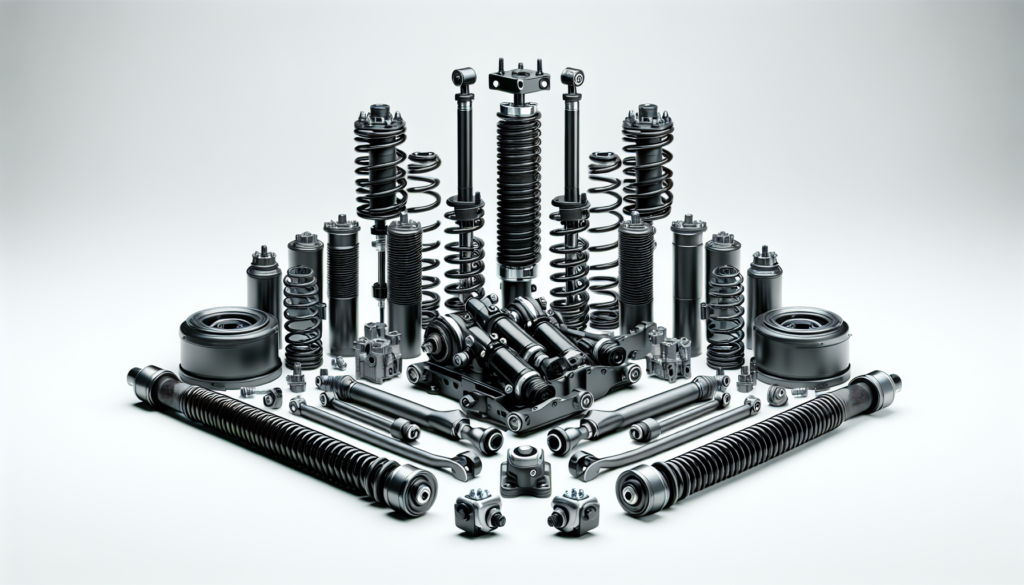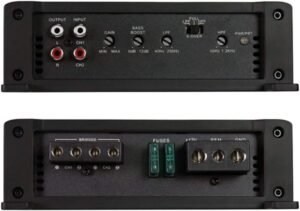
Embarking on the journey to upgrade your vehicle’s suspension can truly transform your driving experience, elevating both comfort and performance. With the right suspension kit, you’ll navigate bends with poise and tackle rough surfaces with ease. This Suspension Kit Selection Guide is your trusty companion, tailored to help you pinpoint the perfect match for your ride. It charts the landscape of options and steers you through the crucial considerations, from understanding the nuances of spring rates to the importance of shock absorber compatibility, ensuring your selection leads to miles of smooth cruising and tailored handling.

This image is property of images.pexels.com.
Understanding Vehicle Suspension Systems
Definition of a Suspension System
Your vehicle’s suspension system is a crucial component that connects the wheels to the rest of the vehicle. It’s designed to absorb the impact from the road, provide stability by keeping the wheels on the ground, and ensure comfort by reducing the amount of noise, bumps, and vibrations that you feel inside the cabin.
Key Components of a Suspension System
The suspension system comprises several key components, including shocks and struts, springs, control arms, and anti-roll bars. These parts work together to manage the impact and forces exerted on the vehicle, providing you with a smooth and controlled ride.
How Suspension Affects Vehicle Performance
A well-functioning suspension system is essential for the performance of your vehicle. It affects handling, braking, and comfort. The system needs to be responsive and adaptable to different road conditions to maintain optimum contact between the tires and the road surface, enhancing safety and performance.
Types of Suspension Systems
There are various types of suspension systems, including independent and dependent systems. Independent systems allow each wheel to move independently, while dependent systems have a solid connection between opposite wheels. The choice of system affects ride quality, handling, and the ability to navigate various terrains.
Assessing Your Suspension Needs
Analyzing Your Driving Habits
When thinking about your suspension needs, consider your driving habits. If you’re frequently driving on smooth highways, your requirements will differ from those who enjoy taking rugged off-road trails. Your driving style informs the type of suspension system that will best suit your needs.
Considering the Terrain
The terrain you typically drive on is a critical factor when assessing your suspension system. Rough, uneven terrains require a more robust system that can handle the irregularities, whereas smooth urban roads may prioritize comfort over durability.
Importance of Vehicle Type and Weight
Your vehicle’s type and weight influence the kind of suspension system you should consider. Heavy-duty trucks will need stronger components than a lightweight sports car. Understanding the dynamics and limitations of your vehicle is essential in choosing the right suspension setup.
Determining Performance Goals
Finally, reflect on your performance goals. Are you aiming for comfort, improved handling, better load-carrying capacity, or all-around performance? Your goals will help narrow down the specifics of what you’re looking for in a suspension kit.

This image is property of images.pexels.com.
Factors Influencing Suspension Kit Selection
Ride Quality vs. Performance
When selecting a suspension kit, you need to balance ride quality against performance. A soft suspension may offer more comfort but may not provide the precise handling that a firmer setup would. Conversely, performance-focused drivers often lean toward a stiffer setup, accepting a rougher ride for increased control.
Durability and Longevity Concerns
The durability and longevity of a suspension kit should not be overlooked. Investing in high-quality components can save you money and trouble in the long run, as cheaper parts may wear out faster and require more frequent replacements.
Compatibility with Vehicle Model
It’s essential to ensure that the suspension kit you’re interested in is compatible with your vehicle model. Incorrectly matched components can lead to performance issues or even safety hazards. Always check for compatibility before making a purchase.
Adjustability and Customization Options
Consider whether you want a fixed setup or one that’s adjustable. Some suspension kits offer customization options that allow you to fine-tune the ride to your liking, which can be especially beneficial for drivers who face variable driving conditions or who enjoy tweaking their vehicle’s performance.
Different Types of Suspension Kits
Standard Replacement Kits
Standard replacement kits are ideal if you’re looking to restore your vehicle’s original ride quality and handling characteristics. These kits typically replicate the factory suspension settings, providing an effective solution for worn-out components.
Lift Kits for Off-Roading
Lift kits are designed for off-road enthusiasts. They provide higher ground clearance, allowing for larger tires and improving the vehicle’s ability to navigate through rough terrain without damage. If you’re an adventurer, a lift kit might be just what you need.
Lowering Kits for Improved Handling
Lowering kits are aimed at those who want improved handling and a lower center of gravity. They can reduce body roll, enhance grip, and give your vehicle a sportier aesthetic. However, a lower ride height might not be practical for all driving conditions.
Air Suspension Kits for Adjustable Ride Height
Air suspension kits offer a versatile option, enabling you to adjust the ride height and firmness with the push of a button. This is perfect for drivers who need flexibility, such as those who switch between city driving and moderate off-road adventures.
Performance Suspension Kits
Performance suspension kits are tailored for drivers looking for the ultimate handling and responsiveness. These kits often include upgraded parts like stiffer springs and shocks, and sometimes come with customization options for track enthusiasts to dial in their preferred settings.

This image is property of images.pexels.com.
Budget Considerations for Suspension Upgrades
Cost vs. Value in Suspension Kits
When budgeting for suspension upgrades, consider the cost against the value you’re getting. It can be tempting to go for the cheapest options, but investing in quality parts can provide better performance and longevity, giving you more value for your money in the long run.
Understanding the Long-Term Investment
Upgrading your suspension is a long-term investment. Quality kits can improve safety, ride comfort, and potentially even the resale value of your vehicle. Think about the future benefits rather than just the upfront costs.
Where to Allocate Your Budget
Determine which components are most critical for your needs and allocate your budget accordingly. There’s no need to spend on high-performance parts if comfort is your priority. Make sure your spending aligns with your goals.
Hidden Costs in Suspension Kit Installation
Be aware of hidden costs such as installation fees, wheel alignments, or additional modifications that might be necessary after installing a new suspension kit. Factor these into your budget to avoid surprises.
The Role of Shock Absorbers and Struts
Difference Between Shocks and Struts
Shock absorbers and struts are often mentioned together, but they have distinct roles. Shocks are part of the overall suspension system that absorb impacts, while struts are a structural part of the suspension system and can affect alignment. Knowing the difference helps in making informed decisions about replacements.
Impact on Ride Comfort and Control
Both shocks and struts critically impact ride comfort and control. They reduce the bounce you feel when driving over bumps and help maintain tire contact with the road, ensuring better handling and stability.
Signs of Wear and Need for Replacement
Look out for signs of wear such as a bouncy ride, uneven tire wear, or fluid leaks from the shocks or struts. If you’re experiencing any of these, it might be time for a replacement to restore ride quality and safety.
Selecting the Right Shocks and Struts for Your Kit
When choosing shocks and struts, consider your vehicle’s specifications and your driving needs. If you’re upgrading your suspension, select components that complement the kit and enhance overall performance.

Installing Your Suspension Kit
DIY Installation vs. Professional Installation
Decide whether you want to install your suspension kit yourself or get it done professionally. DIY installation can save you money, but it requires a good understanding of your vehicle’s mechanics, whereas professional installation guarantees a job well done with less hassle for you.
Tools and Equipment Needed
If you opt for DIY installation, you’ll need a set of tools including sockets, wrenches, and possibly a spring compressor. Ensure you have all necessary equipment before starting the installation to avoid any roadblocks.
Common Installation Mistakes to Avoid
Common installation mistakes include not tightening bolts to the proper specifications, incorrect installation of components, and failing to perform a wheel alignment afterwards. Avoid these to ensure a successful suspension upgrade.
Post-Installation Inspection and Testing
After installation, carefully inspect all components for correct fitment and function. Take your vehicle for a drive to ensure everything feels right and consider getting a wheel alignment to ensure your vehicle’s handling is optimized.
Maintaining Your Suspension System
Routine Checks and Maintenance Tips
Regularly check your suspension system for signs of wear or damage. Keep an eye out for worn bushings, leaking fluids, or damaged components, and address these issues promptly to maintain optimal performance.
When to Replace Suspension Components
Replace suspension components when they show signs of failure or at manufacturer-recommended intervals. Proactive replacement can prevent larger issues and ensure consistent vehicle performance.
Impact of Maintenance on Vehicle Longevity
Keeping up with suspension maintenance can have a significant impact on your vehicle’s longevity. A well-maintained suspension system contributes to the overall health of your vehicle and can prolong its lifespan.
Upkeeping for Optimal Performance
Regular upkeep will ensure that your suspension system continues to perform at its best. This includes periodic inspections, cleaning, and immediate attention to any problems that arise.

Legal and Safety Considerations
Understanding Vehicle Height Regulations
Before making any changes to your vehicle’s height, be aware of local regulations regarding lift or lowering limits. Making illegal modifications can lead to trouble with law enforcement and potentially invalidate your insurance.
Ensuring Road Safety and Compliance
Always ensure that any modifications you make to your vehicle do not compromise road safety or compliance with the law. Safety should always be your top priority.
Impact of Modifications on Vehicle Warranty
Be conscious that suspension modifications can impact your vehicle’s warranty. Check with your manufacturer or warranty provider before making changes to understand any potential consequences.
Off-Road versus On-Road Legalities
Off-road modifications may not be legal for on-road use. Verify that any changes you make are appropriate for the intended driving conditions, and adhere to any specific legal requirements.
Purchasing Channels and After-Sales Support
Deciding Where to Buy: Online vs. Brick-and-Mortar Stores
Choosing where to buy your suspension kit can impact the support you receive. Online stores may offer convenience and variety, while brick-and-mortar stores can provide personalized service and immediate availability.
Evaluating the Quality of After-Sales Service
Consider the quality of after-sales service when purchasing a suspension kit. Good support can include help with troubleshooting, warranty claims, and access to replacement parts if needed.
Accessing Instructional Guides and Installation Resources
Look for suppliers that offer instructional guides and installation resources. These can greatly aid in the installation process, especially if you plan to do it yourself.
Importance of Support for Future Upgrades and Replacements
Lastly, think about future upgrades and replacements. Establishing a relationship with a reputable supplier can provide you with valuable support and advice as you continue to modify and maintain your vehicle.

